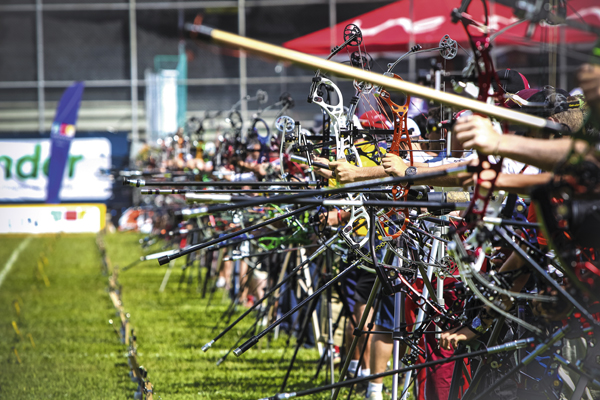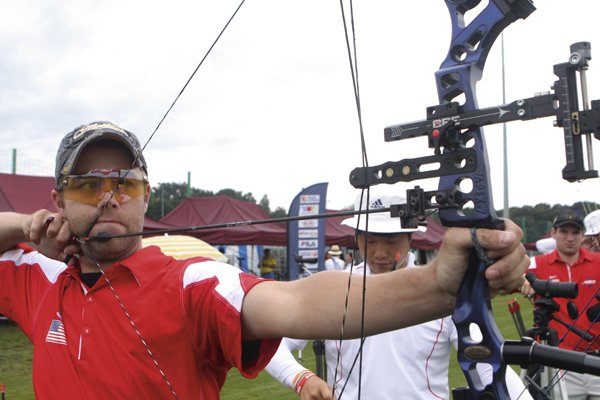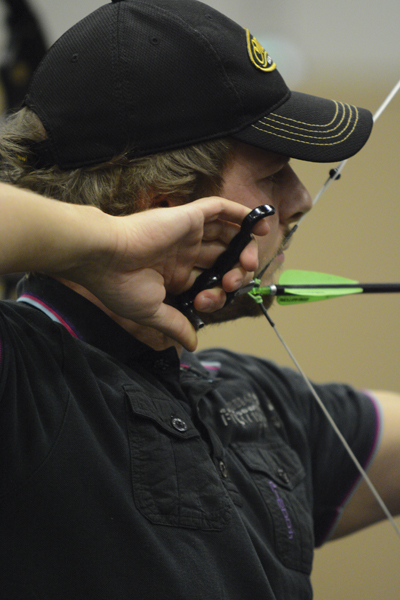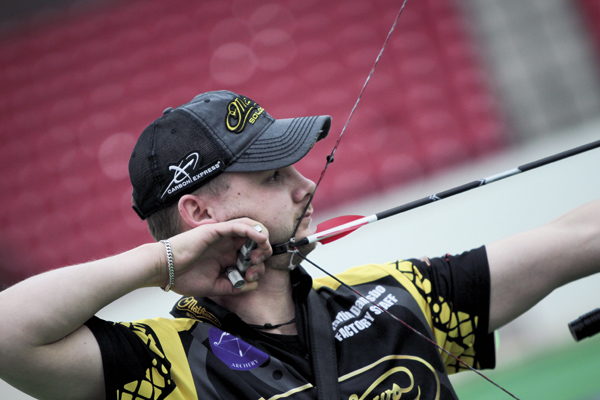Chris Bell explains the steps to take to getting your bow to hold well – involving less tuning than you might think
There is no getting away from it: shooting high scores with a compound bow requires you to hold it still. The less the sight pin moves during the shot execution, the smaller your groups will be. But how are some people able to aim like a machine, whereas others seem destined to aim like a washing machine (on a spin cycle)?
The thing most archers tend to focus on when trying to get their sight pin movement to slow down is their stabilisation. At first glance, this makes sense; the main function of the stabiliser is to balance the bow so that it resists the small movements made by the archer, resulting in less sight pin movement overall. But how much improvement can we expect to make by tuning the stabilisation? Think about the forces acting on the bow: A typical “fully loaded” compound bow mass could be 7lb or 128 ounces, while typical bow holding weight (60lb peak, 65 per cent let off) would be 21lb or 336 ounces. So typically we are holding a bow that weighs about 128 ounces, with about 336 ounces of draw weight when aiming, and we expect to get the sight pin to behave by adjusting our stabilisers by a couple of ounces. This type of tuning probably isn’t going to help much unless everything else is pretty close to perfect. So how do we get our sight pin movement to slow down?
Stabilisation is just a small part of a much bigger picture. I have broken this picture down into six components. They are, roughly in order of importance:
- Practice
- Draw length
- Execution pressure/preload
- Nutrition/hydration
- Stabilisation
- Tiller/Nock point
Although there is too much to cram into a single article, I will go through each point and give you some general advice on what to aim for. This should be enough to highlight any areas where you might be losing a lot of points.
Practice
This might seem obvious, but good old-fashioned practice is the most important factor in this equation. Practising is the only way to develop the fine muscle control needed to hold the bow really steady. For me, using a combination of short and long practice sessions is the most effective way to improve. Long practice sessions are the best way to increase your strength and muscle conditioning. This is because muscles are under tension for a longer period of time, so your brain has longer to improve its ability to control them. Your muscles will respond to the strain you put them under by adapting and growing stronger. Short practice sessions are also really useful. Not only are they much easier to fit into your daily routine, you should be able to maintain your concentration for the entire duration of the session. You will shoot a similar number of arrows as you do in a tournament, so you can treat each one as a practice tournament. I tend to shoot my best if I get in two to three short practice sessions a week (at two or three hours each) and one to two long practice sessions a week (four hours plus). The more practice the better!
Draw Length
Draw length is almost as important as practice when it comes to aiming well. Too short a draw length and you will not be able to achieve skeletal alignment, meaning your muscles will be doing too much work. A short draw length might perform fairly well during practice sessions when you are relaxed, but as soon as you are under pressure with elevated adrenaline and heart rate, your aiming will deteriorate very noticeably. It is very important that your skeleton is in-line and supporting the majority of bow weight, with your muscles mainly used for the fine control elements of aiming and execution.
Too long a draw length is equally as big a problem. In this scenario, when you try and apply the pressure required to execute your shot, your shoulder joint will become over-extended, your back muscles will compress against your spine, and you will have very little control over either your aim or your execution. There are a few key pointers when it comes to getting your draw length right:
- Your draw length should be roughly your arm span (fingertip to fingertip) divided by 2.5.
- Your bow shoulder should be low, with your upper bow arm at a very slight angle to your torso
- Your bow arm should be almost straight. n Your nock point should be slightly further back than the corner of your mouth, about an inch above the bottom of your jaw bone.
- Your wrist should be roughly in line with the back of your head.
The best way to check your draw length is to get someone to take pictures of you and compare your proportions to the best archers in the world (Martin Damsbo, Braden Gellentien and Pierre-Julien Deloche all have epic form, and are great examples of archers to compare your proportions and alignment to).

Stablisers are essential in getting a good hold, but tweaking them won’t completely solve hold or aiming problems
Execution pressure/preload
Think again about the 21lb, or 336 ounces, of weight that we are holding when aiming. This can easily be increased by several pounds by pulling against the cam stop during the anchor and execution phases of the shot. Increasing holding weight can be a very effective way to slow down your sight pin movement in windy or nervous situations. It is really common for archers to stop putting any pressure into the shot when they reach the bottom of the draw valley. Timid shots like this will usually mean that you struggle to get the release to fire subconsciously and without a lot of sight pin movement.
It takes experimentation and practice to find the optimal amount of load to apply and to apply it consistently, but generally getting this right will see a much more dramatic improvement in shot steadiness than fine-tuning your stabilisation. Pressure-activated release aids such as the Carter Evolution can be great tools for experimenting with loading against the cam stop. Try increasing the release pressure by about ½lb a time until your hold starts to deteriorate (again, too much preload can be just as detrimental as not loading at all). When you get the preload right, you should be able to make strong, positive shots with minimal pin movement that don’t go to pieces as soon as the wind blows or you get a bit nervous.
Nutrition/Hydration
Poor nutrition and hydration can really upset your performance, especially in a tournament situation. Dehydration, excessive caffeine consumption and large fluctuations in blood sugar will all have a negative impact on both mental and physical performance.
Your muscles need to be properly hydrated to perform effectively. When competing, aim to drink a litre of water every couple of hours (more in hot weather). By the time you feel thirsty you are already quite dehydrated, so make sure you are not using thirst as your cue to drink.
Caffeine is an archer’s worst enemy. It can make you feel more nervous, cause you to shake, and ruin your concentration. I would recommend staying away from it completely before and during competitions.
Your diet can have a really big impact on how well you are able to aim. Eating any kind of food will cause your blood sugar to rise, while not eating will cause your blood sugar to drop. Too high or too low a blood sugar will ruin your hold. To keep your blood sugar at a stable level, eat small meals regularly from a balanced range of protein, carbohydrate and fat. I aim to eat about 250 calories an hour while competing and avoid eating more than 500 calories in any single meal. This is slightly more calories than required, but I have found a calorie surplus to be far less detrimental to bow hold than a calorie deficit (low blood sugar will cause you to shake more than high blood sugar).
Stabilisation
I don’t want to write too much about stabilisation here, simply because world-class scores have been shot with such a varied array of stabiliser setups that it is hard to provide any general advice on the subject. However, unless you have a really good reason not to, you are probably best following these guidelines:
- A log rod a facing forwards couple of inches longer than your arrow length.
- A rear rod facing backwards about half your arrow length.
- About three times the amount of weight on the rear rod as the long rod.
- As much weight as you can comfortably shoot.
“Neutral” stabiliser setups like this have become almost universal among professional archers. They are very effective at resisting movements from the archer. To put it simply: “They just work”.
Tiller/Nock point
Adjusting the tiller and nock point to achieve better hold characteristics can be a bit of a “black art”, because it can have a big impact on bow tune as well as bow hold. There is not much point in having a bow hold perfectly on the target if your arrow flight is so bad that your bow becomes extremely critical to shoot. However, getting the tiller and nocking point right can make your bow much easier to aim.
On my Mathews Apex 7, I will usually take a couple of twists out of the bottom limb bolt, then re-centre the nock point through the centre of the rest holes in the riser. There isn’t much information on this type of tuning, but getting the nock point closer to the centre of the string (as measured from your top and bottom axles) tends to make the bow sit steadier on aim. When I shoot the Conquest 4, I reverse this process. It’s probably only worth doing if you are an experienced archer who is looking for that “little extra”. Try experimenting with various tiller and nocking point settings to see how it impacts the aiming characteristics.
In summary, holding steady requires a lot of things to be correct, but the most important things are practice, form and draw length. Getting these right will mean you are using your skeleton to do the hard work, resulting in an easier, more repeatable and stronger aiming process. Once you have this right, you can start to fine tune everything else and your scores should soar.





Liked the article, i really enjoy reading about the type of preparation and setups of world class archers.
Getting into their thoughts if you will.
Big like for the article! Very detailed and right on target. Thank you!